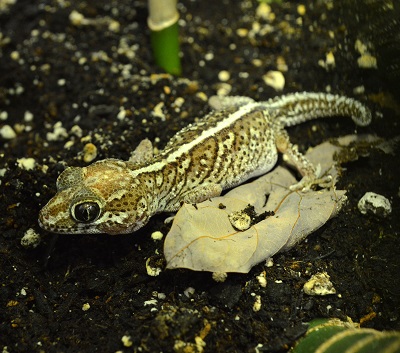
So long, farewell, auf wiedersehen, good-bye! It’s only fitting that we send off our Animal of the Month for August with many different ways to say “see you later” because, as we tweeted (or posted) @ExoticPetVets, the pictus gecko has many different common names. But if you misssed that tweet, or any of the others throughout the month, we have a summary for you right here. Did you know?:
- The pictus gecko (Paroedura picta) is a small gecko species endemic to southern and southwestern Madagascar.
- Pictus geckos are also known by many different commonly-used names; including the ocelot gecko, the painted ground gecko, the Madagascar ground gecko, the big-headed gecko and the panther gecko.
- Because they are terrestrial and not arboreal, pictus geckos are most often found on the ground. Occasionally, they may climb onto a small shrub or other low-growing vegetation.
- The habitat of wild pictus geckos is leaf litter on the floors of Madagascar’s southern forests.
- One of the forests that wild pictus geckos call home is the Madagascar spiny thicket – a unique ecoregion considered one of the most important in the world. It is on the World Wildlife Fund’s list of Global 200 Ecoregions.
- The Madagascar spiny thicket is not only home to pictus geckos and other wildlife found nowhere else on Earth, but also to unique plants and trees such as the octopus tree (Didierea madagascariensis).
- Pictus geckos are among the smaller gecko species, growing to a length of 10 – 15 cms (4 – 6″) from the tips of their snouts to the tips of their tails. Some males can reach lengths of 20 cms (8″). Females are generally smaller.
- Pictus geckos naturally have a base colour that is brown or a reddish-brown with a variety of lighter and darker coloured splotches and bands along their backs, heads, legs and tails. Their bellies are a cream colour.
- Selective breeding of captive pictus geckos in the pet industry has created many different colour morphs including snow, caramel albino, anerythristic, xanthic, stripe and normal.
- Big-headed gecko is one of the many other common names ascribed to the pictus gecko and there’s a good reason for that. Relative to their size of their small bodies, pictus geckos have big heads with big eyes.
- Pictus geckos have long, thick tails that they use to store fat and water. This helps them survive in the wild when food is scarce and during dry periods.
- Like the vast majority of gecko species, pictus geckos don’t have eyelids so they can’t close their eyes.
- Pictus geckos have a transparent scale called a spectacle over each eye to help protect their eyes and keep them moist.
- To keep their eyes clean, pictus geckos will use their flexible tongues to lick their eyeballs.
- When they feel threatened, pictus geckos will drop their tails. Dropping their tails is a means of escaping the clutches of their predators.
- Pictus geckos can regrow their tails and while they may not be exactly the same, the regenerated tails are reasonably similar to the original ones with which they were born.
- Snakes, larger reptiles, and birds of prey are among the predators of pictus geckos.
- Pictus geckos are insectivores, which means that they dine on insects and their larvae.
- As ambush predators, pictus geckos don’t aggressively forage or pursue their prey – instead, they will wait for the insects to come to them. When their prey happens by, they will grab them by surprise.
- Some say that pictus geckos are nocturnal while others describe them as crepuscular – so which is it? Well, it’s both.
- Pictus geckos are active at night, making them nocturnal. But their preferred time to stalk and eat their prey is during the twilight hours of dusk and dawn, which makes them crepuscular too.
- One thing’s for certain – pictus geckos are not diurnal and will spend their days sleeping in places where they can hide and feel safe; such as, small crevices, under rocks or fallen leaves and/or bark.
- With proper care in captivity, pictus geckos usually live about 10 years. But they are capable of living to 15 years.

